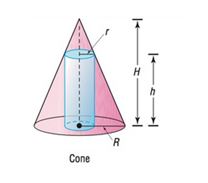
Concept explainers
21. Inscribing a Cylinder in a Cone Inscribe a right circular cylinder of height h and radius r in a cone of fixed radius R and fixed height H. see the illustration. Express the volume V of the cylinder as a function of r.
[Hint: . Note the similar triangles.]

To find: To express the Volume of the cylinder as a function of .
Answer to Problem 21AYU
Solution:
Explanation of Solution
Given:
A right circular cylinder of height and radius is inscribed in a sphere of fixed radius and fixed height .

Calculation:
To express the Volume of the cylinder as a function of :
Volume of a cylinder .
From the figure, based on the properties of similar triangles, the ratio of sides can be written as
Therefore,
Hence, the volume of the cylinder is .
Chapter 2 Solutions
Precalculus
Additional Math Textbook Solutions
University Calculus: Early Transcendentals (4th Edition)
Thinking Mathematically (6th Edition)
Algebra and Trigonometry (6th Edition)
Calculus for Business, Economics, Life Sciences, and Social Sciences (14th Edition)
A Problem Solving Approach To Mathematics For Elementary School Teachers (13th Edition)
Elementary Statistics: Picturing the World (7th Edition)
- The OU process studied in the previous problem is a common model for interest rates. Another common model is the CIR model, which solves the SDE: dX₁ = (a = X₁) dt + σ √X+dWt, - under the condition Xoxo. We cannot solve this SDE explicitly. = (a) Use the Brownian trajectory simulated in part (a) of Problem 1, and the Euler scheme to simulate a trajectory of the CIR process. On a graph, represent both the trajectory of the OU process and the trajectory of the CIR process for the same Brownian path. (b) Repeat the simulation of the CIR process above M times (M large), for a large value of T, and use the result to estimate the long-term expectation and variance of the CIR process. How do they compare to the ones of the OU process? Numerical application: T = 10, N = 500, a = 0.04, x0 = 0.05, σ = 0.01, M = 1000. 1 (c) If you use larger values than above for the parameters, such as the ones in Problem 1, you may encounter errors when implementing the Euler scheme for CIR. Explain why.arrow_forward#8 (a) Find the equation of the tangent line to y = √x+3 at x=6 (b) Find the differential dy at y = √x +3 and evaluate it for x=6 and dx = 0.3arrow_forwardQ.2 Q.4 Determine ffx dA where R is upper half of the circle shown below. x²+y2=1 (1,0)arrow_forward
- the second is the Problem 1 solution.arrow_forwardc) Sketch the grap 109. Hearing Impairments. The following function approximates the number N, in millions, of hearing-impaired Americans as a function of age x: N(x) = -0.00006x³ + 0.006x2 -0.1x+1.9. a) Find the relative maximum and minimum of this function. b) Find the point of inflection of this function. Sketch the graph of N(x) for 0 ≤ x ≤ 80.arrow_forwardThe purpose of this problem is to solve the following PDE using a numerical simulation. { af (t, x) + (1 − x)= - Ət af 10²ƒ + მე 2 მე2 = 0 f(ln(2), x) = ex (a) The equation above corresponds to a Feynman-Kac formula. Identify the stochastic process (X)20 and the expectation that would correspond to f(t, x) explicitly. (b) Use a numerical simulation of (X+) above to approximate the values of f(0, x) at 20 discrete points for x, uniformly spaced in the interval [0,2]. Submit a graph of your solution. (c) How would you proceed to estimate the function f(0.1, x). (Briefly explain your method, you do not need to do it.) Extra question: You can explicitly determine the function in (b) (either as a conditional expectation or by solving the PDE). Compare the theoretical answer to your solution.arrow_forward
- A sequence is given by the formula an = n/2n^2 +1 . Show the sequence is monotone decreasing for n >1. (Hint: What tool do you know for showing a function is decreasing?)arrow_forwardA sequence is given by the formula an = n 2n2 +1 . Show the sequence is monotone decreasing for n 1. (Hint: What tool do you know for showing a function is decreasing?)arrow_forwardDifferentiate #32, #35arrow_forward
 Calculus: Early TranscendentalsCalculusISBN:9781285741550Author:James StewartPublisher:Cengage Learning
Calculus: Early TranscendentalsCalculusISBN:9781285741550Author:James StewartPublisher:Cengage Learning Thomas' Calculus (14th Edition)CalculusISBN:9780134438986Author:Joel R. Hass, Christopher E. Heil, Maurice D. WeirPublisher:PEARSON
Thomas' Calculus (14th Edition)CalculusISBN:9780134438986Author:Joel R. Hass, Christopher E. Heil, Maurice D. WeirPublisher:PEARSON Calculus: Early Transcendentals (3rd Edition)CalculusISBN:9780134763644Author:William L. Briggs, Lyle Cochran, Bernard Gillett, Eric SchulzPublisher:PEARSON
Calculus: Early Transcendentals (3rd Edition)CalculusISBN:9780134763644Author:William L. Briggs, Lyle Cochran, Bernard Gillett, Eric SchulzPublisher:PEARSON Calculus: Early TranscendentalsCalculusISBN:9781319050740Author:Jon Rogawski, Colin Adams, Robert FranzosaPublisher:W. H. Freeman
Calculus: Early TranscendentalsCalculusISBN:9781319050740Author:Jon Rogawski, Colin Adams, Robert FranzosaPublisher:W. H. Freeman
 Calculus: Early Transcendental FunctionsCalculusISBN:9781337552516Author:Ron Larson, Bruce H. EdwardsPublisher:Cengage Learning
Calculus: Early Transcendental FunctionsCalculusISBN:9781337552516Author:Ron Larson, Bruce H. EdwardsPublisher:Cengage Learning





